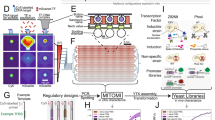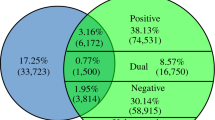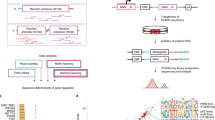Abstract
Several computational methods based on microarray data are currently used to study genome-wide transcriptional regulation. Few studies, however, address the combinatorial nature of transcription, a well-established phenomenon in eukaryotes. Here we describe a new approach using microarray data to uncover novel functional motif combinations in the promoters of Saccharomyces cerevisiae. In addition to identifying novel motif combinations that affect expression patterns during the cell cycle, sporulation and various stress responses, we observed regulatory cross-talk among several of these processes. We have also generated motif-association maps that provide a global view of transcription networks. The maps are highly connected, suggesting that a small number of transcription factors are responsible for a complex set of expression patterns in diverse conditions. This approach may be useful for modeling transcriptional regulatory networks in more complex eukaryotes.
This is a preview of subscription content, access via your institution
Access options
Subscribe to this journal
Receive 12 print issues and online access
$209.00 per year
only $17.42 per issue
Buy this article
- Purchase on Springer Link
- Instant access to full article PDF
Prices may be subject to local taxes which are calculated during checkout




Similar content being viewed by others
References
Kel, O.V., Romaschenko, A.G., Kel, A.E., Wingender, E. & Kolchanov, N.A. A compilation of composite regulatory elements affecting gene transcription in vertebrates. Nucleic Acids Res. 23, 4097–4103 (1995).
Quandt, K., Grote, K. & Werner, T. GenomeInspector: basic software tools for analysis of spatial correlations between genomic structures within megabase sequences. Genomics 33, 301–304 (1996).
Yuh, C.H., Bolouri, H. & Davidson, E.H. Genomic cis -regulatory logic: experimental and computational analysis of a sea urchin gene. Science 279, 1896–1902 (1998).
Wang, J., Ellwood, K., Lehman, A., Carey, M.F. & She, Z.S. A mathematical model for synergistic eukaryotic gene activation. J. Mol. Biol. 286, 315–325 (1999).
Halfon, M.S. et al. Ras pathway specificity is determined by the integration of multiple signal-activated and tissue-restricted transcription factors. Cell 103, 63–74 (2000).
Fickett, J.W. & Wasserman, W.W. Discovery and modeling of transcriptional regulatory regions. Curr. Opin. Biotechnol. 11, 19–24 (2000).
Brazma, A., Jonassen, I., Vilo, J. & Ukkonen, E. Predicting gene regulatory elements in silico on a genomic scale. Genome Res. 8, 1202–1215 (1998).
van Helden, J., Andre, B. & Collado-Vides, J. Extracting regulatory sites from the upstream region of yeast genes by computational analysis of oligonucleotide frequencies. J. Mol. Biol. 281, 827–842 (1998).
Spellman, P.T. et al. Comprehensive identification of cell cycle-regulated genes of the yeast Saccharomyces cerevisiae by microarray hybridization. Mol. Biol. Cell. 9, 3273–3297 (1998).
Tavazoie, S., Hughes, J.D., Campbell, M.J., Cho, R.J. & Church, G.M. Systematic determination of genetic network architecture. Nature Genet. 22, 281–285 (1999).
Wolfsberg, T.G. et al. Candidate regulatory sequence elements for cell cycle–dependent transcription in Saccharomyces cerevisiae. Genome Res. 9, 775–792 (1999).
Hughes, J.D., Estep, P.W., Tavazoie, S. & Church, G.M. Computational identification of cis -regulatory elements associated with groups of functionally related genes in Saccharomyces cerevisiae. J. Mol. Biol. 296, 1205–1214 (2000).
Cho, R.J. et al. A genome-wide transcriptional analysis of the mitotic cell cycle. Mol. Cell 2, 65–73 (1998).
Chu, S. et al. The transcriptional program of sporulation in budding yeast. Science 282, 699–705 (1998).
DeRisi, J.L., Iyer, V.R. & Brown, P.O. Exploring the metabolic and genetic control of gene expression on a genomic scale. Science 278, 680–686 (1997).
Eisen, M.B., Spellman, P.T., Brown, P.O. & Botstein, D. Cluster analysis and display of genome-wide expression patterns. Proc. Natl. Acad. Sci. USA 95, 14863–14868 (1998).
Roberts, C.J. et al. Signaling and circuitry of multiple MAPK pathways revealed by a matrix of global gene expression profiles. Science 287, 873–880 (2000).
Jelinsky, S.A., Estep, P., Church, G.M. & Samson, L.D. Regulatory networks revealed by transcriptional profiling of damaged Saccharomyces cerevisiae cells: Rpn4 links base excision repair with proteasomes. Mol. Cell. Biol. 20, 8157–8167 (2000).
Zhu, G. et al. Two yeast forkhead genes regulate the cell cycle and pseudohyphal growth. Nature 406, 90–94 (2000).
Koranda, M., Schleiffer, A., Endler, L. & Ammerer, G. Forkhead-like transcription factors recruit Ndd1 to the chromatin of G2/M-specific promoters. Nature 406, 94–98 (2000).
Oehlen, L.J., McKinney, J.D. & Cross, F.R. Ste12 and Mcm1 regulate cell cycle–dependent transcription of FAR1. Mol. Cell. Biol. 16, 2830–2837 (1996).
Arndt, K.T., Styles, C. & Fink, G.R. Multiple global regulators control HIS4 transcription in yeast. Science 237, 874–880 (1987).
Umemura, K. et al. Derepression of gene expression mediated by the 5′ upstream region of the isocitrate lyase gene of Candida tropicalis is controlled by two distinct regulatory pathways in Saccharomyces cerevisiae. Eur. J. Biochem. 243, 748–752 (1997).
Reed, S.H., Akiyama, M., Stillman, B. & Friedberg, E.C. Yeast autonomously replicating sequence binding factor is involved in nucleotide excision repair. Genes Dev. 13, 3052–3058 (1999).
Morse, R.H. RAP, RAP, open up! New wrinkles for RAP1 in yeast. Trends Genet. 16, 51–53 (2000).
Roth, F.P., Hughes, J.D., Estep, P.W. & Church, G.M. Finding DNA regulatory motifs within unaligned noncoding sequences clustered by whole-genome mRNA quantitation. Nature Biotechnol. 16, 939–945 (1998).
Dequard-Chablat, M., Riva, M., Carles, C. & Sentenac, A. RPC19, the gene for a subunit common to yeast RNA polymerases A (I) and C (III). J. Biol. Chem. 266, 15300–15307 (1991).
Gasch, A.P. et al. Genomic expression programs in the response of yeast cells to environmental changes. Mol. Biol. Cell 11, 4241–4257 (2000).
Causton, H.C. et al. Remodeling of yeast genome expression in response to environmental changes. Mol. Biol. Cell 12, 323–337 (2001).
Werner, T. Models for prediction and recognition of eukaryotic promoters. Mamm. Genome 10, 168–175 (1999).
Koch, C., Moll, T., Neuberg, M., Ahorn, H. & Nasmyth, K. A role for the transcription factors Mbp1 and Swi4 in progression from G1 to S phase. Science 261, 1551–1557 (1993).
Iyer, V.R. et al. Genomic binding sites of the yeast cell-cycle transcription factors SBF and MBF. Nature 409, 533–538 (2001).
Bussemaker, H.J., Li, H. & Siggia, E.D. Regulatory element detection using correlation with expression. Nature Genet. 27, 167–171 (2001).
Leem, S.H., Chung, C.N., Sunwoo, Y. & Araki, H. Meiotic role of SWI6 in Saccharomyces cerevisiae. Nucleic Acids Res. 26, 3154–3158 (1998).
Wagner, A. Genes regulated cooperatively by one or more transcription factors and their identification in whole eukaryotic genomes. Bioinformatics 15, 776–784 (1999).
Mewes, H.W. et al. MIPS: a database for genomes and protein sequences. Nucleic Acids Res. 28, 37–40 (2000).
Zhu, J. & Zhang, M.Q. SCPD: a promoter database of the yeast Saccharomyces cerevisiae. Bioinformatics 15, 607–611 (1999).
Bulyk, M.L., Huang, X., Choo, Y. & Church, G.M. Exploring the DNA-binding specificities of zinc fingers with DNA microarrays. Proc. Natl Acad. Sci. USA 2001, 12 (2001).
Aach, J., Rindone, W. & Church, G.M. Systematic management and analysis of yeast gene expression data. Genome Res. 10, 431–445 (2000).
Acknowledgements
We thank J. Hughes for providing many of the motifs used in these analyses and U. Keich for assistance with the statistical analyses of motif synergies. We are grateful to J. Aach, B. Cohen, A. Derti, P. D'Haeseleer, A. Dudley, M. Kupiec, R. Mitra, F. Roth, D. Segré and M. Wright for advice and suggestions. Y.P. was a scholar of the Fulbright Foundation. We are grateful to the US Department of Energy and National Science Foundation and to the Lipper Foundation for grant support.
Author information
Authors and Affiliations
Corresponding author
Supplementary information
Rights and permissions
About this article
Cite this article
Pilpel, Y., Sudarsanam, P. & Church, G. Identifying regulatory networks by combinatorial analysis of promoter elements. Nat Genet 29, 153–159 (2001). https://doi.org/10.1038/ng724
Received:
Accepted:
Published:
Issue Date:
DOI: https://doi.org/10.1038/ng724
This article is cited by
-
Additional insights into the organization of transcriptional regulatory modules based on a 3D model of the Saccharomyces cerevisiae genome
BMC Research Notes (2022)
-
Assessing regulatory features of the current transcriptional network of Saccharomyces cerevisiae
Scientific Reports (2020)
-
Construction of gene causal regulatory networks using microarray data with the coefficient of intrinsic dependence
Botanical Studies (2019)
-
Synthetic Promoters: Designing the cis Regulatory Modules for Controlled Gene Expression
Molecular Biotechnology (2018)
-
Genome-scale biological models for industrial microbial systems
Applied Microbiology and Biotechnology (2018)




